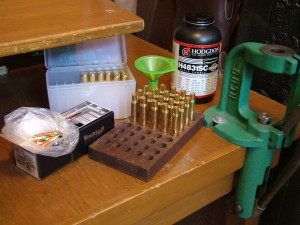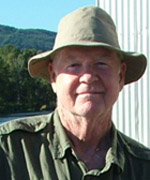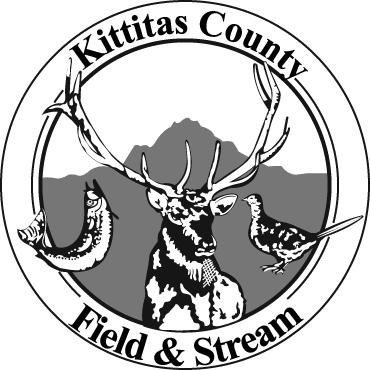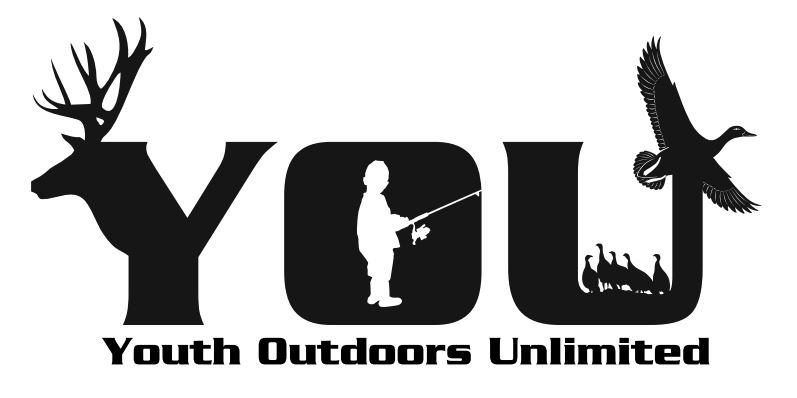Archive for June, 2014
All About Reloading, Debates and Modern Bullets
I think we settled questions of value, importance and pleasure around loading your own ammo last week. While I have been talking about rifle ammo, I’d be happy to make the case for rolling your own shotgun and handgun ammo as well.
Today, let’s consider the ongoing discussion around one component of the cartridges we put together (arguably the most critical); the bullets themselves.
A well-constructed hunting rifle bullet is traditionally made up of a lead, or lead alloy, core with a copper “jacket” wrapped around it. The ideal bullet for a given rifle will depend on its intended use, although accuracy from shot to shot is always key. Many varmint hunters will seek a carefully manufactured, well balanced bullet that will hold together at very high velocity and essentially explode on impact. A big game hunter will want a bullet which expands as it enters the body of the animal, making a wound channel larger than the diameter of the bullet and delivering the full force of the shot, resulting in a quick and humane death. (Bullet diameter is measured in hundredths of an inch and may be anything from .17 to .50 caliber or larger.) The bullet required for a huge thick-skinned moose will be substantially different than that sought for the thin-skinned, and much smaller, pronghorn or deer. Endless arguments revolve around the perfect caliber, bullet weight and speed for a given hunt.
Vast amounts of time and money have gone into creating dependable “traditional” rifle bullets in a wide variety of calibers and sizes, using copper and lead. For shotguns, the move from lead shot to steel, bismuth, tungsten or other non-toxic shot was made decades ago to protect critters from the lead poisoning they suffered after dredging up lead shot or eating dead birds with lead in them. A few years ago, studies of the effects of eating meat from animals shot with rifle bullets containing lead hit the news.
The study which started the flap involved a Peregrine Fund board member who collected a hundred one-pound packages of ground venison from food pantries in North Dakota, and found lead fragments using CT scans. More testing at the University of Iowa found that about sixty percent of the ground meat contained some lead. Along the way, as the findings were told and retold, some writers – sportsmen of one or another stripe – took potshots at hunters feeding their families lead. One writer slammed Safari Club International over its “Sportsmen Against Hunger” program (game meat given to food pantries), suggesting that the donated game meat poisoned the poor receiving it.
Lead poisoning is a big deal, and lead in game meat had actually been studied for some time. At www.springerlink.com/content/bfpm6clj036w3vkw/ is a 2002 article in the European Food Research and Technology Journal, “Intake of lead from game meat – a risk to consumers’ health?” The gist of the article, comparing hunters and the general population, was that “…individual blood lead concentrations of the hunters did not correlate with the number of their weekly game meat meals. [I]t was concluded that frequent consumption of wild game meat has no significant effect on blood lead levels.”
After the food bank flap, the North Dakota Department of Public Health studied 738 residents. Eighty percent consumed wild game taken with lead. Participants who consumed wild game averaged .30 micrograms/dl more lead in their blood than those who did not. The kicker was that all participants were well below the 25 micrograms/dl “level of intervention” for adults, and the participant average lead levels of 1.17 micrograms/dl were below the average American’s lead level of 1.60.
Turns out that most of that lead was found in ground meat, which was mostly prepared by commercial cutters and wrappers. Seems that hunters who cut and prepare their own game meat generally are much more thorough about removing the meat around the wound channels (where lead fragments are found) and they generally make less ground meat.
Bottom line: lead poisoning from consuming game taken with bullets containing lead is not a serious concern. Safety is really about, as The Old Man preached, taking care of the food you are given as if you were going to feed it to your family.
Still, there are compelling reasons to load with non-lead, and I have an online recommendation.
Put together by biologists and hunters Ben Smith, Jim Petterson and Leland Brown, this web site is hunter and conservation friendly. These guys work at one level or another with the Institute for Wildlife Studies and have been involved for years with killing and removing feral hogs from Pinnacles National Park (formerly Pinnacles National Monument) in the Salinas Valley of Central California. You will find a rational, interesting and thorough discussion of every aspect of the lead vs. non-lead bullet question at www.huntingwithnonlead.org.
The things you learn will add to the pleasure of rolling your own ammo.
Comments Off on All About Reloading, Debates and Modern Bullets
Reloading Ammo in This Modern Age
For some reason, I am up to my elbows in brass, primers, powder and bullets lately. I’m dealing with new and used brass, and a variety of powders and bullet weights, types and calibers, for four different rifles. It seems that son-in-law Chris, son Edward, and I have all shot up enough ammo that it is time to roll some more.
Each of us, and each of  our rifles, has a preference for bullet weight and shape and the type and amount of powder it takes to get the bullet out of the barrel and to the point of aim downrange. The barrel of the rifle itself will have a lot to do with all of this, as well. Each barrel has a “twist” in its rifling (the rifling spins the bullet so that it flies straight – like a football). Twist varies from one turn in nine inches to 1:20 or whatever, and will change the consistency and accuracy with which a given bullet flies.
our rifles, has a preference for bullet weight and shape and the type and amount of powder it takes to get the bullet out of the barrel and to the point of aim downrange. The barrel of the rifle itself will have a lot to do with all of this, as well. Each barrel has a “twist” in its rifling (the rifling spins the bullet so that it flies straight – like a football). Twist varies from one turn in nine inches to 1:20 or whatever, and will change the consistency and accuracy with which a given bullet flies.
This “preference” is based on other things, as well. First, after a hundred or more rounds are fired at paper, it becomes obvious that certain bullet shapes and weights more consistently strike the same spot on a target than others. Somewhere in that conversation will be the amount and type of gunpowder which burns in the brass case, forming the gases which push the bullet down the barrel at some velocity (there are fast- and slow-burning powders designed for case size, bullet weight and so on). Second, field experience over the years, in hunting deer, elk, antelope and other game informs the preference for a particular cartridge combination. The ongoing quest for more accuracy and maximum effectiveness on game is quite fascinating, really.
Then, of course, one company or another is always coming out with a more accurate or efficient bullet design or a more consistent powder. Add to this various studies about the effects of lead in the environment or in meat, and the rising cost of certain key metals used in bullets, and a given rifle’s preference can be, so to speak, a moving target.
And all of the above – along with significant savings on the cost of our shooting – makes hand loading ammo as relaxing, rewarding and fun today as it was when I started. There is just something about the sheer pleasure of being responsible for everything that happens when you pull the trigger and watch bullet after bullet hit the target where you want it to hit.
I got the reloading bug five decades ago this summer. I finally brought my shiny new Savage 110 Premiere Grade 7mm Remington magnum home from layaway and went target shooting. Somewhere in the middle of my second box of factory ammo, it dawned on me that, at my salary, I’d never be able to shoot as much as I wanted.
I picked up a press and dies and powder and bullets and instruction manuals. Over a couple years of squeezing off thousands of rounds of handloads, I learned about accuracy – and what my rifle needed to shoot the way I intended. When bullets didn’t go exactly where I wanted, I knew why, and made adjustments.
I began to really know my rifle, and myself. Brother-in-law Claude picked up a 7×64 Sharpe & Hart, and we loaded for it, too. We became skilled enough that our shooting – through bets at the old Aurora Gun Club – paid for our reloading supplies and tools.
Over time, reloading helps in developing a strong relationship with the tools we take afield. I came to understand my part and the rifle’s part of our hunting agreement. I the rifle become, as the Old Man used to say, “an extension of yourself and a guarantee of meat in the pot.”
So, these days, I load for my 7mm and .270 and a couple rifles my boys use. Each of them has had time with me rolling their own, and each pays a lot of attention to his own rifle’s preferences.
If I had my way, all hunters would have to go through the process of learning to roll their own ammo. It ain’t gonna happen soon, I’m sure. Still, there are quite a few handloaders in the valley, and plenty of all the supplies and tools you will ever need. Bill Essman is an NRA certified reloader, and one day he might be convinced to start a class. In the meantime, Three Forks Ammo & Reloading in Cle Elum has everything you need, and Chris teaches hand loading classes on a regular basis. He’ll answer all your questions at 509-674-2295.
It’s simple, wise and moral; the more you know about your firearms, the more skill you will develop in their use. Rolling and shooting your own ammo will help you master hunting and ensure the future of our enterprise.
Next week, we’ll talk about bullets and lead.
Differently Abled Hunters Go Loaded for Bear
This is a story of two 14-year-olds – one boy and one girl – whose families opted to get them as far into deep-forest bear hunting as possible. At one level, they are just ordinary youngsters who want to hunt and fish and bathe in fresh air and sunshine like any other kid. At another level – the one involving wheelchairs, shooting skills, a little extra help and steadfast determination reflected in huge smiles – Amy Moore and Dariece Steele are anything but ordinary.
Of course, this is also about Youth Outdoors Unlimited (Y.O.U.). You met founders Cindy and Joe Carpenter a few months ago, who drove over on a Monday evening from Moses Lake. That monthly meeting of the Kittitas County Field & Stream Club was about celebrating 95 years of working for the outdoor future of Paradise.
We talked a bit about the Club’s proposed Washington Kids (that means all kids) Outdoor Bill of Rights: “The children of Washington have the right to discover and experience the outdoors through activities including the following: Create an outdoor adventure; Explore a trail; Camp under the stars; Go fishing; Discover nature; Explore Washington’s heritage; Go on a picnic; Play in a park, in the water, in the snow, on the rocks; Go hunting; Learn to be safe around firearms and other outdoor tools.”
Cindy and Joe updated us on their Y.O.U. program, a tax exempt 501(c)3 corporation focused on making hunting and fishing dreams come true for young people diagnosed with life-threatening illness and/or physical disability. In less than a handful of years, the program has thrown the outdoors wide open for dozens of kids who really need to taste life with fewer limits.
As of that evening, a dozen youngsters were in the pipeline for 2014 camping, hunting or fishing trips. Fishing trips are tailored for the kids wanting them – from warm water spiny-rays to salmon over 30 pounds. Hunting is most commonly for turkeys, white-tail or mule deer or bears. Fish or game harvested is carefully processed for the table and the trophy is mounted. Each hunter or fisher gets a photo record of their big adventure. Whatever special clothing, custom-fitted gear or chair or firearm required or needed is provided by the program and its sponsors.
Funding is from banquets, fundraisers and generous sponsors who also provide products to move the program forward. Sponsors include Sportsman’s Warehouse, Cabela’s, Wholesale Sports Outdoor Outfitters, Vortex Optics, Gunwerks, Brothers ‘N Arms and several handfuls of custom clothing or equipment manufacturers. Through it all, the staff and editors of Horns & Hooks Magazine have been elbow to elbow with Joe and Cindy and Y.O.U.
At any rate, in the last couple months, two of the dozen youngsters – Dariece and Amy – have been on successful black bear hunts.
Dariece Steele was born with spina bifida – not a big enough bump in the road to keep him from his black bear appointment. With his folks, Gary and Sue, his brother Devan and sister Dacia, he made the journey from home in Olympia to the Quinault Reservation north of Ocean Shores. There, they met Tandy Charley, Dariece’s Quinault bear guide. They also hooked up with Y.O.U. guide Rex Peterson and cinematographer Jeff Berg, both with Horns and Hooks Magazine. On the Quinault ground, they became familiar with the country and the new Y.O.U. camo “track chair” which, if needed, would get Dariece into places his normal chair might not. The 14-year-old demonstrated his shooting skill on a couple targets, they all played on the beach ‘til dark, then turned in to rest up for the hunt.
There are a lot of bears in the dense Quinault forests. Late on the third day in those woods, the right bear came to them, Dariece made a perfect shot. His family is enjoying some of the finest meat Washington has to offer and Dariece is looking forward to seeing the shoulder mount being prepared for him by God’s Creation Taxidermy.
Not long after Dariece made his hunt, Amy (who suffers from the chromosome disorder known as Turners Syndrome) embarked on her great bear hunting adventure. On the Willow River of British Columbia, this 14-year-old demonstrated her own coolness under pressure and took another beautiful spring black bear.
Thus begins another year of helping youngsters see new possibilities as abled outdoor people. Fishing, camping and fall hunting are now lining up for the rest of the young people awaiting their 2014 adventures.
Y.O.U. makes bigger openings into the outdoors. Check out www.youthoutdoorsu.org.
Comments Off on Differently Abled Hunters Go Loaded for Bear
Going Flat Out for Flat Fish
For a number of us, I think, summer and fall adventures begin in February, at the Central Washington Sportsmen Show down the Yakima River in the SunDome. I signed myself and various homeys up for big water chases after halibut and tuna.
Our tuna run awaits us in September. The halibut run happened a couple weeks back.
In February, at Captain Don Davenport’s booth (www.oceansportfishing.com), he introduced me to dashing young Captain Steve “Need for Speed” Connally. Steve’s craft is The Rock-n-Roll, the smallest and fastest boat in the group’s fleet. Speed is all good (since fishermen can board a bit later and still be the first on any given fishing ground), but Steve’s consistent success with both halibut and ling cod was a bigger plus. What really got my signature – and our three names – on the line was his obvious enthusiasm for fishing, fishermen and the Pacific Ocean. Homey Kirk Johnson, Boyfriend-in-law Brian Smith and I would spend a Sunday in May fishing out of Westport.
Thus, sometime shortly after 4:30 a.m. on a Sunday in late may, we three and our three new best friends crossed the bar from Gray’s Harbor and headed west into the vast Pacific. Flat out for big flat fish, we skipped across the low ocean swells and passed around most of the Westport fleet which had left the harbor well before us.
As promised, we were one of the first boats drifting across the halibut flat a couple football fields below us. Deckhand Will Stoll and Captain Steve coached and cajoled, as needed. They kept baits fresh,quickly invited our slowly-drawn-from-the-depths halibut onboard, and just as quickly got them safely stowed. They were all nice fish, but Kirk coaxed an exceptional halibut out of the depths. As Kirk wrestled with that big flat hog, I hooked into one of my own. Unfortunately, mine turned into a 15-pound skate as it came aboard. While I was anxious to get back to the business of catching my own fat halibut, I did enjoy the debate about who was going to return the three-foot-wide winged skate to the water. Will, as I recall, lost the debate and gingerly slid the skate back into the ocean. He then cheered me on as my bait dropped the 600 feet down to the hungry mouth of the 20-some-odd-pound halibut I would happily take home.
By the time the last of the Westport fleet arrived, and the water around us was well-stocked with eager fishers, we had caught our limits (one apiece) of halibut. We waved a fond farewell to our fellows and headed to Steve’s secret ling cod honey hole.
There, at significantly less depth, we found ourselves almost immediately wrestling with eight- to 15-pound lings. Among them were more than a few sea bass – rockfish – in the five pound range. I have caught keeper lings in Canada, but in twenty years of bottom fishing from Westport I had only enjoyed watching others catch legal-sized lings. This day became special.
In not much over an hour, we each had our two-ling limit. In the middle of it all, Brian caught a fish we reckoned to be over 30 pounds. That hog was big enough (maybe) to win the daily $500 pot for biggest ling. Together, his smile and anticipation of spending the $500 were almost insufferable, but we congratulated him anyway. Once the bite settled, and ling limits were confirmed (including my first!), Will and Captain Steve went to work calculating how many rockfish were on board.
Our rockfish limits were ten fish each. We averaged almost six at that point.
As it turned out, Cap had virtually always limited on halibut and was generally close on rockfish and/or lings. He had never filled the Rock-n-Roll’s limit on all three. Suddenly, a new record loomed ahead – we just needed more sea bass.
We picked up a handful more from another shallow reef, and that bite quit. We did it again at our next stop. Time wound slowly down and Cap had one more special sea bass stop. Unfortunately, the currents repeatedly drove us off the fish. Captain Steve shrugged, we agreed, and the day was called at something over six rockfish apiece. So close, yet so far. …And so many smiling fishermen.
We skipped back into port, Will went to work filleting fish, and our big halibut and ling went to the Westport weigh-in. Kirk’s halibut was big enough to stay atop the leader board – for an hour or two. Brian’s 30-pound ling somehow shrunk to 22 pounds, but still led the money race until someone’s bigger fish forced him to watch the 500 bucks slip through his fingers.
It was a near-perfect day for making big delicious fish fillets and great memories aboard the Rock-n-Roll.
We’ll do it again.
Comments Off on Going Flat Out for Flat Fish
All about Memory Bank Accounts
As we awaited the social event of the spring – the Ellensburg Rodeo Hall of Fame pairing of 2014 artists and sponsors – at Fitterer’s Furniture a couple weeks back, Homey Jerry Lael and I had a confab.
As you know, any time two or more of us gather in the name of the outdoors, a meeting of the Reecer Creek Rod, Gun, Working Dog & Outdoor Think Tank Benevolent Association is automatically convened. The primary agenda item for this meeting was consideration of the richness and value of good memories.
We started with how the artists, working on steer skulls this year, would create memories that will only brighten with time. In moments, we were reliving some of our own treasured memories – memories from our outdoor lives deposited into “memory bank accounts” long years ago.
For a few minutes, we revisited a deer hunt Jerry had with his father. As he recounted the experience, I was right by his side, watching a deer hunt which was at once hugely successful (a big buck right there), an abject failure (missed shot), and an all-time great memory bank deposit (“Wow! I can still see that buck and feel that instant!”).
As Jerry re-deposited that memory and was pulled away to attend to pressing business, I found myself lost in one of my own priceless deer hunting memories; four decades ago, I watched a nice buck slip from a patch of timber, cross a sage meadow, and duck into a couple-hundred-foot-long thicket of tall brush we called mountain mahogany. I figured he was looking for a place to lie low for a while. There was a little wind, and it occurred to me that I might be able to make a good sneak, if I took my time. Over the next half hour, rifle at the ready, I inched into that breeze and examined anything that might be a deer part. Suddenly, not ten feet away, the buck startled to his feet. I threw up my rifle, but at that distance the riflescope was filled by a gigantic, wide-open eye of buck. In an blink he was gone, noisily crashing from the thicket. I stood, shaking like a leaf, searing that eyeball picture into my account.
This “memory bank account” concept is one I’ve valued since buddy Rick Doell and I started talking about how our youthful ice fishing trips in Colorado blizzards would surely get warmer and more successful as we relived them later in our lives. This was the author’s point in an article we read in one of the outdoor mags sometime in the 1960s. The guy wrote of opening such an account for hunting, fishing, camping, hikes with kids and parents – about anything people might do together to enrich their lives. He figured you could make countless withdrawals without ever drawing down the account. In fact, he surmised, every time a favorite memory was lifted from the account, it would be savored, enjoyed and returned with more value than when it was withdrawn. (Interestingly, 50 years later, I have to strain to remember the frostbitten fingers, noses and toes that accompanied the fat rainbows drawn from the holes Rick and I chipped through the ice.)
We often quoted the author’s premise that “nothing is more important than regular deposits into your account. When you’re 90 years old, will you be better served by the polished and preserved memories of times afield with buddies and family or by the papers crossing your desk? Work with pride—but make those memory bank deposits.”
I have long thought that well-rounded people need to be outside at every opportunity – banking memories for dreary or stressful times. I encouraged my students to take “well days,” rather than come to class sick, and suggested a couple days during each quarter to take care of themselves – to bank some memories. Students were still responsible for the material covered, but far more likely to return ready to play.
The late L.L. Bean, the guy who started the mail order sporting goods business, had it figured out. He took his business very seriously (he was the first to offer his customers their money back if they were dissatisfied for any reason). Every employee had to be an outdoor nut of some ilk, and every item sold by the company was – still is apparently – field tested by those employees. Bean was also serious about his play time. When he was in his 80s, he was still going strong, fishing and hunting at every opportunity. He noted one day that he was on a stream with several of the same buddies with whom he’d fished and hunted as a boy. They were all reaching old age blessed with good health. “It dawned on me,” he said, “that the Good Lord must not count against the sum of a man’s days, those days spent in pursuit of fish and game.”
I like the concept. For some years, I was the morning weather anchor on KOA radio in Denver. If a day was particularly beautiful, I might urge people to take the day off and make some memories which would brighten their twilight years. Then I’d say, “Just tell your boss I said it was okay.”
So, take a day off and go play outside. Deposit a memory. Tell your boss Jerry and I said it was okay.
Comments Off on All about Memory Bank Accounts







